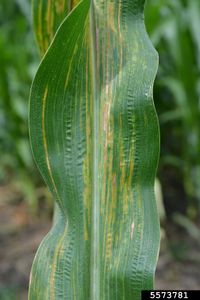Xanthomonas vasicola pv. vasculorum
| Literature database |
|---|
| 20 articles sorted by: |
| • year (recent ones first) |
| • research topics |
| • countries/regions |
| • host plants |

Author: Vinicius Garnica
Source: IPM Images
Xanthomonas vasicola pv. vasculorum (Cobb, 1894) - (bacterial leaf streak of corn)
This pathovar of Xanthomonas vasicola infects corn/maize, causing bacterial leaf streak. It also attacks sugarcane (gummosis) and eucalypt trees. It has been known as a pathogen of maize, sugarcane and eucalypt trees in South Africa since the 1940s, but initially caused little damage. In 2014, bacterial leaf streak on maize was recorded in Nebraska, U.S.A., and by 2020, the disease had spread to other parts of the U.S., as well as to Argentina and Brazil in South America.
On maize, the symptoms start with isolated streak lesions, often exudating bacterial droplets. The lesions enlarge and become more numerous, eventually merging and covering a significant portion of the leaf area. In North America, the disease causes serious outbreaks in maize fields, often with a disease incidence above 90% in irrigated fields, and resulting in high yield losses.
In South Africa, X. vasicola pv. vasculorum has not been reported frequently from maize, but causes the serious gumming disease on sugarcane. The symptoms of that disease include stalk deformation, internal discoloration, and the formation of gum pockets, containing bacteria. In addition, this pathovar is causing outbreaks in eucalypt plantations near sugarcane fields as well as in eucalypt nurseries.
Synonyms:
Xanthomonas campestris pv. vasculorum type B
For a review see Ortiz-Castro et al. (2020),